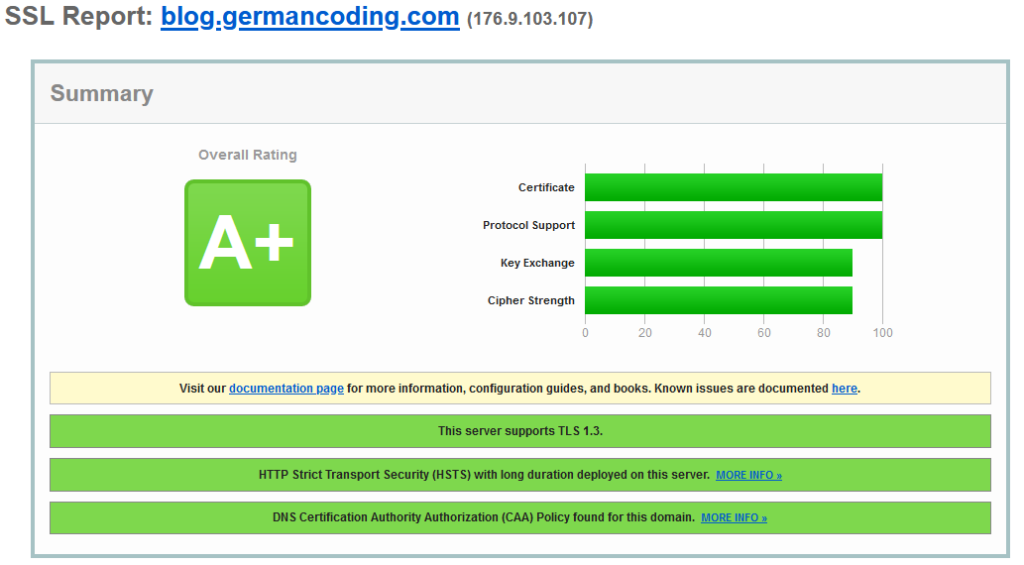Please do not try to reach a 100% score on SSLabs.
I’ve seen this numerous times on the Let’s Encrypt forums and so I felt the need to scream out: Please don’t do this.
A small introduction to SSLabs and it’s ratings
The website SSLabs provides a service that checks SSL/TLS hosts for their security level, scans for typical TLS issues and displays a final score upon finishing scanning.
Users not familiar with the inner workings of TLS probably don’t understand much of the displayed data. It is therefore natural for these users to interpret the data they understand most – the score. The score is displayed at the top of the results page and may look like this:

As you can see here, there’s an “overall rating”. The highest possible value is A+, the lowest rating is F (or various connection error states). Besides the rating, there’s also a percentage score (0 – 100%), divided into four categories:
- Certificate – The score of the site’s certificate
- Protocol support – A score, based on which protocol versions are supported by the server
- Key Exchange – Score based on the strength of all available key exchanges
- Cipher strength – Score based on the strength of all available cipher suites
If you look at my screenshot, you should notice that I’ve got 100% only in two categories – Certificate and Protocol Support. The other two categories are only at 90%. Why is that, and why shouldn’t I fix that?
Before we dive into the details, the reader should be aware that the rating system of SSLabs constantly changes. Future versions may work differently and this information may not be up to date.
Category 1 – the certificate
Getting 100% is pretty simple here, and most users don’t need to do anything to achieve this. According the the SSLabs rating guide, the certificate is evaluated by typical misconfigurations or weaknesses, and points are deducted if anything is out of the usual. Most CA’s (like Let’s Encrypt) will generally not issue “bad” certificates, so there’s not much room for issues here. There are some things to misconfigure though, e.g a bad or incomplete cert chain – SSLabs will show a warning in the results if something was found.
Category 2 – protocol support
We could talk ages about what SSL/TLS version exist, and which you should use or shouldn’t use, but I’m going to make it short: Trust me, or trust Mozilla’s Guidelines, or trust one of the million sites that have great scores on SSLabs:
Use TLSv1.2 and TLSv1.3 only. Do not enable anything lower (anything newer doesn’t exist at the time of writing). Doing this will also get you the 100% score on SSLabs in terms of protocol support. TLSv1.2 is twelve years old, so compatibility isn’t a factor unless you need to support extremly old things (in that case you should consider isolating the legacy systems).
Category 3 – key exchange
Now it gets interesting. This is one of two categories where I don’t have 100%. And you shouldn’t either. In order to get 100% on key exchange, you would need to make sure that all algorithms used in the key exchange have a theoretical bit security strength that is greater than some arbitrary value set by SSLabs. That is currently at least 4096 Diffie-Hellman, or a 384-bit EC curve or higher. You’re not allowed to offer anything with less size, that would decrease your score (usually to 90%, which is what you see on my site).
So, why are larger keys bad?
They’re not bad, but their increase in security is mostly theoretical. We cannot break a 256 bit EC key, and we also cannot break a 384 bit key. We may be able to do this in the future though, which is why some folks tend to prefer larger keys. However, some researchers say that it is much more likely that a curve is broken by a technical flaw, rather than by true brute-force power. If such a flaw is found, it will most likely affect both the smaller and the larger curves. The value in practice is small.
The downside of a larger key is however, that not all clients support it (also performance). Google Chrome, for example, has dropped support for one the largest NIST curves, secp521r1. You cannot use this curve together with Chromium-based browser, which is the majority of the web. Android 7.0 has a bug, where the only supported elliptic curve is prime256v1. Prime256v1 is one of the smaller curves (256 bits), but statistically the most used ECDSA curve in the public internet.
So, using larger curves will not really increase your strength against an attacker, but will lock out clients without reason. That is why I’m reiterating: A DHE key exchange of 2048-bit is still okay today, and you should also offer smaller curves. You obviously can offer larger values – but do not drop support for the smaller ones yet. Except for things like 1024-bit RSA/DHE1 – that’s dangerously low. But 2048-bit to 4096-bit RSA/DHE is a reasonable range to offer.
Category 4 – cipher strength
The second category where I only have 90%. The reasoning is very similar to category 3 – a higher score kills of clients support, without a strong increase in security level.
Getting 100% here requires all offered block ciphers to have a key length of 256 bits or greater. Anything lower must not be offered. The most famous (and used) block cipher is probably AES. The largest key size available for AES is 256, the lowest 128 bits.
Similar to key exchanges, more bits are not neccessarily more secure. A larger key means more work brute-force wise and generally increases computation work for many attacks. But, there are also attacks, like Cache-timing attacks, that can work even on the large AES-256 keys. So yes, a larger key is a bit better, but it is also a lot slower and security doesn’t increase dramatically.
The major issue again here is, besides performance, that not all clients talk AES256 (in all cipher combinations). For example, according to SSLLabs, Firefox 47 on Windows 7 only speaks AES128-GCM, not AES256-GCM. 256-bit AES-CBC is supported, but we don’t want to talk CBC. So requiring the use of AES256 will again lock out lots of clients.
It is therefore far better to offer both – AES128-GCM and AES256-GCM. If the client supports both, you can still select AES256 by turning on server-side cipher preference (see my older posts on TLS). But do not force it, unless you like killing of clients.
I hope this post has cleared up some misconceptions about the scores on SSLabs, and why a full 100%-score is sacrificing support without better overall security. I also want to remind server operators, that a secure TLS connection is only a part of the deal – a secure site also requires a well-engineered and maintained application behind it. I plan to make some more web-related posts about typical attacks, security headers and similar things in the future.
If you have any questions, feel free to ask below or contact me directly – my email is here somewhere.
